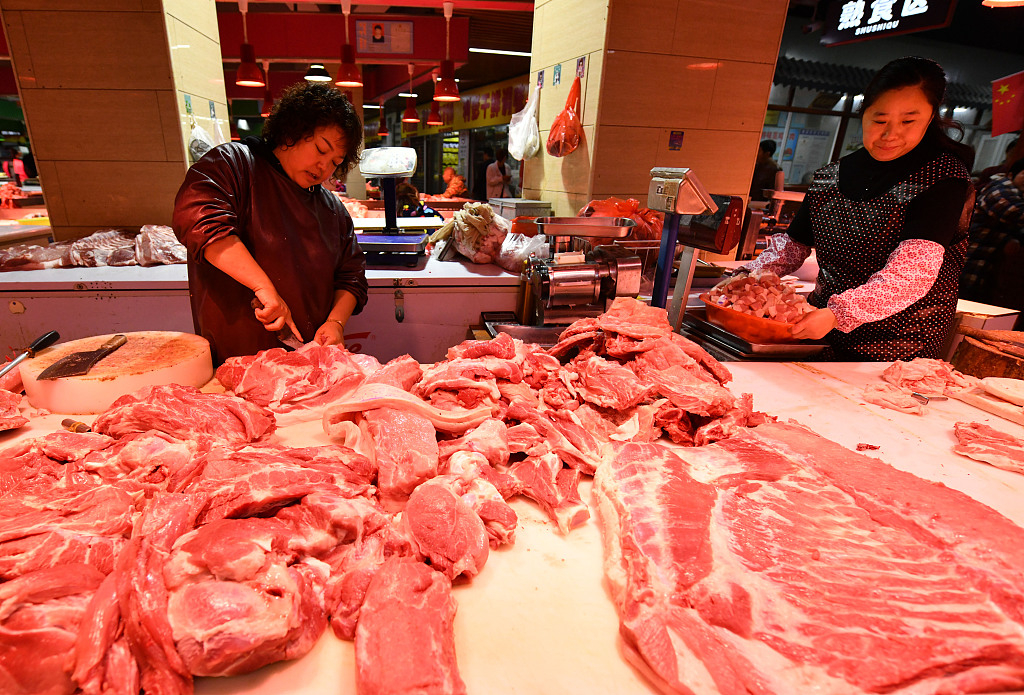
A shopping mall in Fuzhou, China, October 16, 2019. /VCG Photo
A shopping mall in Fuzhou, China, October 16, 2019. /VCG Photo
Editor's Note: Chen Jiahe is the chief strategist at Cinda Securities. The article reflects the author's opinions, and not necessarily the views of CGTN.
The recently published CPI (Consumer Price Index) data of China has astonished many investors. Only six months ago, a CPI above three percent was considered nearly impossible, as the monetary base of China was growing very moderately. Usually, a high inflation rate occurs after a radical expansion of the total amount of money in a society. Such a situation did not exist in China back six months ago. Neither does it exist now.
However, the CPI of China quickly climbed to three percent in September and jumped to 3.8 percent in October. This means the average consumer price index rose by 3.8 percent over one year. Pessimism is starting to spread among investors and the yield of 10-year Treasury bond increased from its trough of around three percent in August to around 3.3 percent. This 30 basis points increment of the 10-year Treasury bond means the relevant price will drop by around three percent.
There are usually two different kinds of reasons behind a fast-rising inflation. The first one is the printing of money. As the growth rate of China's monetary base is now remaining very constant as it was in the past few years, this reason is excluded from our analysis. The M2 growth rate in September was 8.4 percent, which is almost nothing different from the figure in 2018 and the early months of 2019.
The second possible reason behind a rising inflation rate is the lacking of a certain kind of product that is critical to the consumption of citizens. A typical example is the global oil crisis in the 1970s and early 1980s. Political and military conflicts in the Middle East caused the rapid increasing of oil price and the inflation in western societies were pushed to a double-digit level.
Clearly China is now suffering from this second type of causation. As African swine flu swept across the pig farms of China in the past few months, China's pork production has met its hardest time in the past few decades. Many pig farms emptied their reserves and the price of pork doubled or even tripled in local markets. As pork takes an incredibly large part of China's consumer price index, the CPI of China soared as a result.

A peddler chops a piece of pork in a local food market of Fuyang City, China, November 9, 2019. /VCG Photo
A peddler chops a piece of pork in a local food market of Fuyang City, China, November 9, 2019. /VCG Photo
Although it might sound strange to some western investors that the price rising of a single meat product can cause such a large rising to the overall CPI of China, this is the fact as pork composes a large part of Chinese people's daily consumption. The same difficulty might be felt when a Chinese investor is trying to understand why the rising of the price of pizza can cause Italian people spending much more money. The difference in the composition of diet does exist between different societies.
One of the best statistical evidence that supports the fact that the rising of China's CPI in October is almost entirely caused by the rising of pork price is the difference between the CPI data in Ningxia province and the overall national CPI. In October, the CPI of Ningxia province fell to just 1.3 percent, 1.2 percent lower than its record of 2.5 percent in March. This is a clear contrast to the rising of the national CPI.
The reason behind this difference between the CPI in Ningxia and the national average is that pork is not a major consumption item in Ningxia. The full name for Ningxia province is "Ningxia Hui Autonomous Region". As many Hui people have the religion of Islam, pork is not a part of their diet. Therefore, the national shortage of pork is much less felt by the economy of Ningxia and the CPI of this province is even falling from its previous records.
Regarding the future of China's CPI, investors shall not be too pessimistic. Compare with the oil price hike that caused the super-inflation in the western economies in the 1970s and early 1980s, pork is a different kind of product. Many products, such as plastic materials, home appliances, are made partly out of crude oil. Therefore, the rising of oil price can cause an overall price increment among many other relevant products. However, pork is not the raw material of other products. The singular rising of the pork price can hardly affect the price of other commodities. Therefore, at least for now, an overall price increment is still out of our sight.
(If you want to contribute and have specific expertise, please contact us at opinions@cgtn.com)